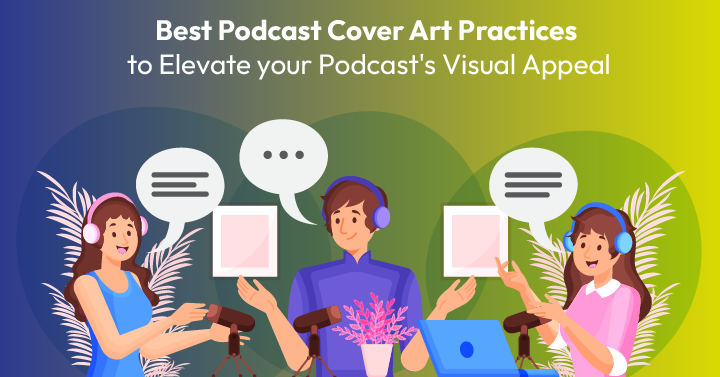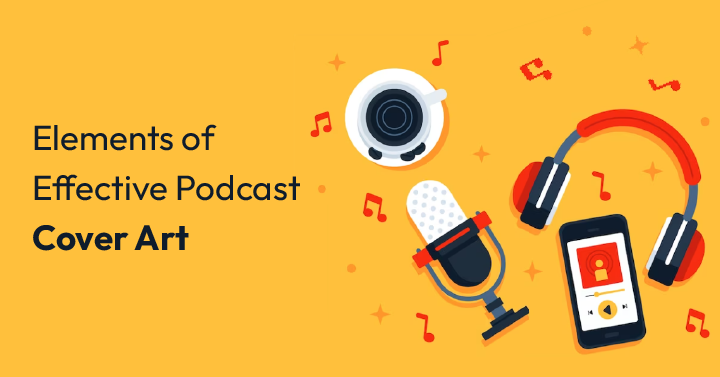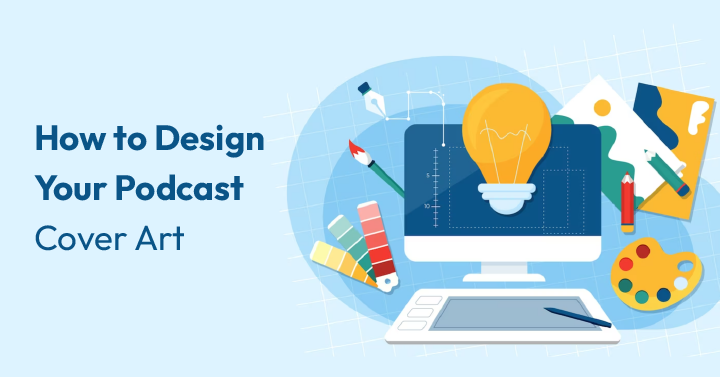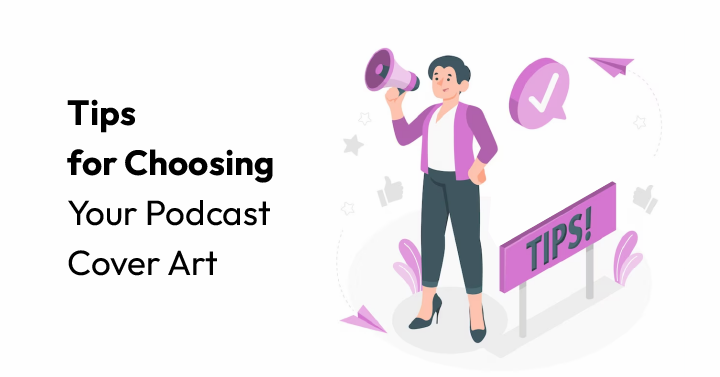
When podcast listeners are scrolling through shows on their smartphones, searching for something new to explore, the thing that stands out most is the podcast cover art. As their eyes flicker over the thumbnails, they make split-second decisions about whether a show is in the genre and style that suits their tastes. Most of the time, they won’t even see a description unless their interest is already piqued.
Given that podcast cover art is often an afterthought, it has an outsized importance in attracting new audiences to a show. That’s why we’ve put together this comprehensive guide to creating podcast designs, including step-by-step instructions and a rundown of the technical specifications required.
1. Why Is Podcast Cover Art Essential?
From a practical perspective, podcast cover art is essential because directories like Apple Podcasts and Spotify will not list your podcast unless it comes with imagery.
Even if podcast cover art wasn’t mandatory, it would be worth expending time and energy on the design because it’s a great chance to convey your brand. The imagery that accompanies your podcast can help you instantly communicate the tone and content of your show.
Plus, in a world where there are estimated to be more than 4 million podcasts, the artwork is a way to make yours instantly stand out from the competitors.
2. Elements of Effective Podcast Cover Art

2.1 Clear and bold typography
Typography sets the tone for your podcast right away. There have been many studies conducted on how typography influences human perception, including one that analyzed how the typeface of a Netflix show represented its content.
To give some basic examples, if the typeface is fun and decorative, like Comic Sans, people will assume your podcast is on a lighthearted subject. Conversely, Cambria is seen as a more serious, mature typecast.
Font is also something to consider when creating a podcast cover art mockup. Different from typecast, font technically refers to a particular style of a typecast. For instance, Daytona Condensed is a font in the Daytona typecast family.
Whatever you decide with regards to typecast and font, never forget that the most important thing is that your podcast title is clearly legible and stands out from the imagery. You want people to go away remembering the name of your show.
2.2 Imagery
Imagery can be as simple as a photo of the host or as unique as a digitally illustrated original artwork.Photos tend to be associated with more straightlaced, serious topics, such as politics, finance or even true crime. They are also common for podcasts that feature a celebrity host.
Illustrations, on the other hand, allow you to be quirkier and more creative. That doesn’t mean your topic can’t be hard hitting, but it does tend to give the design an edgier feel. Alternatively, you could skip the imagery entirely and just include pure text in a striking style, like the podcast Undisclosed.
2.3 Color scheme
On the surface, your color scheme might seem unimportant, but there are a whole lot of connotations buried in the subtext of the spectrum. Red, for instance, is usually associated with strong emotions like love and anger. Of course, you shouldn’t feel overly bound by color psychology. After all, most private podcasts are representative of their creator’s personality to a greater or lesser degree.
If you are looking for some inspiration, there are lots of websites that explore and experiment with color combinations. A popular option for podcast cover art, Canva even has a tool that allows you to pick a hue, then see a range of complementary colors.
2.4 Consistency
Your podcast cover art needs to be in keeping with the rest of your branding. In other words, it should reflect (or be reflected by) your podcast website as well as your social media. A consistent brand presence throughout different media makes your podcast more recognizable. It also reinforces the impression that you have a well-thought-out vision for your show.
Consistency is also about maintaining the same tone within the cover art itself. If your typography suggests fun but the image is of a weeping child, it creates a confusing impression that will likely put off potential listeners who aren’t sure what they’re going to get.
2.5 Unique designs
It might be tempting to phone it in with an automatic podcast cover art generator just so you can meet a podcast directory’s requirements, but you would be wasting a useful branding opportunity. The more unique your design, the more it will draw eyeballs towards your show.
Unique doesn’t have to mean a completely original drawing. It can be about the composition of your cover art and how you blend typography, colors and imagery into a cohesive brand proposition.
3. Technical Requirements for Podcast Cover Art
3.1 File type
No matter what program you use to design your cover art, you’ll need to convert the file to one of the formats accepted by the major podcast directories, such as Apple Podcasts and Spotify. That means that if you were working with Photoshop, for example, you would need to make sure you converted the PSD file into PNG or JPEG once you’d finished editing.
Apple Podcasts: PNG or JPEG
Spotify: PNG, JPEG or TIFF
3.2 Resolution
Resolution impacts the sharpness and clarity of an image. This is usually measured in pixels or dots an image has per inch.
Apple Podcasts: 72 dots per inch
Spotify: Highest available
3.3 Size
Each directory will specify a minimum podcast cover art size in pixels. These dimensions will always be square to fit with the display requirements on podcast platforms. Usually, you will want to make sure the size is as large as possible so that there’s no pixelation.
Apple Podcasts: 1400 by 1400 pixels minimum, 3000 by 3000 pixels recommended
Spotify: 640 by 640 pixels minimum
3.4 Color mode
Color mode is a way to define and describe color mathematically, so that it is depicted in a standard way across different devices. Different color modes will have slightly different hues and shades available, which can affect how your final image appears.
Apple Podcasts: RGB color space
Spotify: sRGB color space, 24 bits per pixel
3.5 Quality
The quality of an image is usually related to its resolution and size. Even for podcast directories that don’t have technical requirements, you don’t want your podcast cover art to look shoddy and unprofessional.
Apple Podcasts: No blurry or pixelated images
Spotify: None specified
3.6 Content
There are certain images that podcast directories will flag as inappropriate and refuse to allow in your artwork.
Apple Podcasts: No explicit language, illegal drugs, violence, placeholder images, ads, sponsor logos or marketing copy. You also cannot use the terms Apple Inc., Apple Podcasts, Apple Music, iTunes Store or iTunes, nor have any visual representation of Apple hardware.
Spotify: None specified
3.7 Legibility
Make sure your typography is readable, even at small sizes. Don’t forget that you won’t know what devices your potential listeners are utilizing.
Apple Podcasts: Encourages simple, legible artwork
Spotify: None specified
4. How to Design Your Podcast Cover Art

4.1 Define your brand identity
What is your podcast all about and who is it for? Answering these two basic questions will help you define your brand identity. Obviously, a podcast about murders in Michigan will have a different tone to one about dad jokes, and this should be reflected in your podcast cover art. While the former might have blood spatter imagery, the latter might contain a jaunty typeface.
Try to summarize what your show is about in a single sentence, then experiment with how that could be conveyed visually.
4.2 Research your competition
A great way to inspire yourself is to see how other podcasts in the same genre or niche as yours have utilized cover art. There might be aspects of their design that you would like to emulate or put your own spin on.
Researching the competition also helps to ensure you create something unique. ‘Great minds think alike,’ as the saying goes, and the last thing you want is to have spent a long time coming up with cover art from scratch, only to discover it markedly resembles somebody else’s podcast design.
4.3 Brainstorm visual concepts
Once you’ve established your brand identity and have taken some cues from competitor podcasts, you can begin to brainstorm your visual concepts. This is a useful step to help open up the possibilities of what your design could contain.
If you want to keep things old school, you can rely on pen and paper to create a word cloud, but there are also a number of free web tools, like Miro, that will help you build a virtual mind map.
4.4 Choose a design tool
There are lots of design tools available, each with their own range of features. Particularly if your initial visual concepts are more complex, you should set aside some time to see which software has the functionality to realize your vision.
If you want a podcast cover art maker free, Canva is a very popular option because it allows for a great deal of customizability. Alternatively, Adobe Express comes with a whole host of podcast cover art templates to get you started.
4.5 Create a rough sketch
The next step is to play around with some different ideas using your chosen design tool. There’s no need to perfect the image at this point, just hash out the general concept.
It may be that something that seemed genius during your brainstorming is actually overly convoluted given the tight dimensions of the podcast cover art format. Creating rough sketches will help you determine which of your ideas strikes the right balance between uniqueness, clarity and composition.
4.6 Experiment with colors and typography
Digital tools make it incredibly easy for you to change your typecast, font and color palette with just a few clicks of the mouse.
For example, you may decide the text isn’t as legible as you would like, or that the color of your podcast title fades into the background hue.
4.7 Incorporate imagery
There are a couple of different ways you can incorporate imagery into your podcast cover art. First, many online tools will come with free-to-use stock illustrations or photographs. Second, you can purchase images from digital creators or stock photo vendors (make sure to check the usage license before buying).
Alternatively, you can upload your own snaps or hand-drawn designs to your chosen tool.
4.8 Optimize for different platforms
You won’t know what kind of device a listener will access your podcast on, so try to create something that is striking and legible regardless of smartphone model or computer interface.
As noted above, different podcast directories have different technical specifications, so you may have to slightly alter the image to comply with the various regulations.
4.9 Test and iterate
Before finalizing your cover art, make sure it will actually look good! Tools like OnlyPod allow you to upload your design to see how it would appear on all the top podcast directories.
You will probably want to use your cover art on your website as well as social media platforms such as Twitter or Facebook, so don’t forget to create iterations that fit different size formats (e.g., banner, icon) and preview them, too.
5. Tips for Choosing Your Podcast Cover Art

5.1 Reflect your brand
The most important thing to remember is that your cover art is an extension of your show’s content. Accurately reflecting your brand through the typography and imagery will help you attract the right listeners for your particular topic.
5.2 Stand out
In a crowded marketplace, your cover art must somehow stand out from the pack. Put in the effort to make sure it is as original and stylish as possible.
5.3 Be relevant
Resist the urge to go for style over substance if it’s going to impact how relevant your cover art is to your topic. We’ve already talked about how important it is to maintain branding consistency so as to build awareness and exude professionalism.
5.4 Be unique
Hopefully, your show has its own distinctive spin that justifies its existence. Your cover art needs to mirror that uniqueness in its design.
5.5 Keep it simple
Creating podcast cover art is a tightrope-walking act: it needs to stand out, be unique, be relevant, reflect your brand and somehow still remain as simple as possible. That might seem like a tough ask, but remember that an overly complicated design will end up looking like a big, colorful, unreadable mess on most smartphone screens.
6. FAQs
- What kind of art for podcast cover?
The most important thing is to choose something that encompasses your show’s topic and style. If it’s a comedic look at motherhood, that should be reflected in your typography and imagery.
- How much does it cost to do cover art for a podcast?
Thanks to the proliferation of free design tools on the web, doing cover art for a podcast can cost absolutely nothing. It just depends on how much customer support and functionality you need.
- What is podcast cover design?
Podcast cover design is the art of encapsulating the essence of your show into a single eye-catching image.
- What colors are best for podcast cover?
There’s no right or wrong color scheme for podcast cover art, since its perception by a casual viewer will be defined by a combination of color palette, typecast and imagery.



